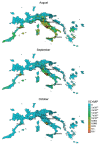Using Big Data to Monitor the Introduction and Spread of Chikungunya, Europe, 2017
- PMID: 31107221
- PMCID: PMC6537727
- DOI: 10.3201/eid2506.180138
Using Big Data to Monitor the Introduction and Spread of Chikungunya, Europe, 2017
Abstract
With regard to fully harvesting the potential of big data, public health lags behind other fields. To determine this potential, we applied big data (air passenger volume from international areas with active chikungunya transmission, Twitter data, and vectorial capacity estimates of Aedes albopictus mosquitoes) to the 2017 chikungunya outbreaks in Europe to assess the risks for virus transmission, virus importation, and short-range dispersion from the outbreak foci. We found that indicators based on voluminous and velocious data can help identify virus dispersion from outbreak foci and that vector abundance and vectorial capacity estimates can provide information on local climate suitability for mosquitoborne outbreaks. In contrast, more established indicators based on Wikipedia and Google Trends search strings were less timely. We found that a combination of novel and disparate datasets can be used in real time to prevent and control emerging and reemerging infectious diseases.
Keywords: Aedes albopictus; Europe; arbovirus; big data; chikungunya; data science; human mobility; social media; vector-borne infections; vectorial capacity; viruses.
Figures






References
-
- Health HSoP. HealthMap. 2016. [cited 2017 Jan 5]. http://www.healthmap.org
Publication types
MeSH terms
LinkOut - more resources
Full Text Sources
Medical

